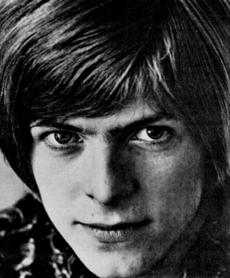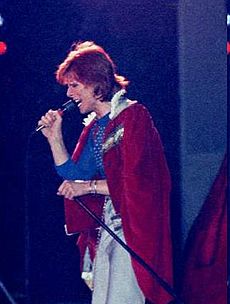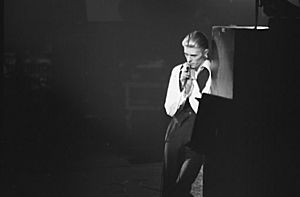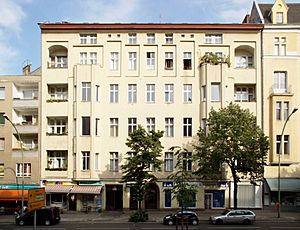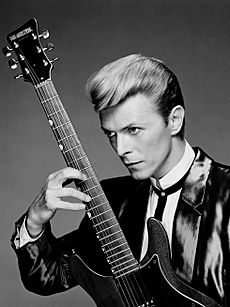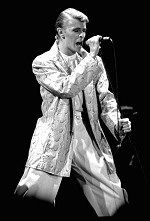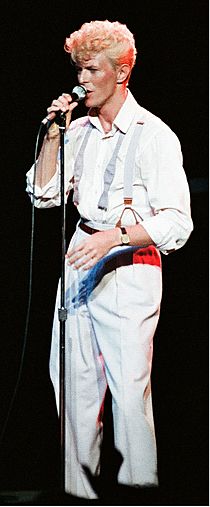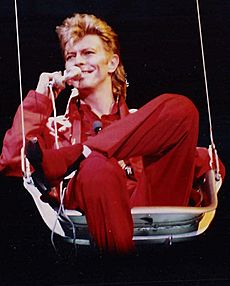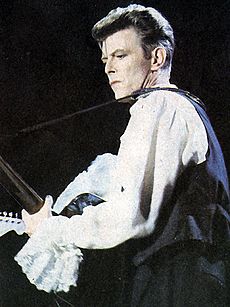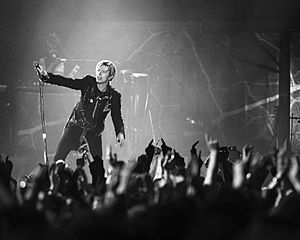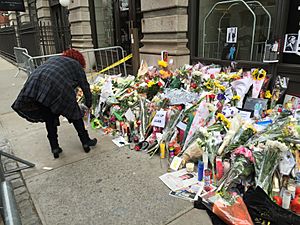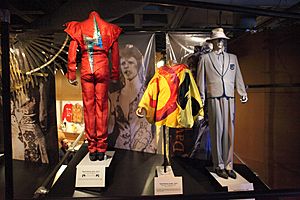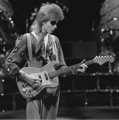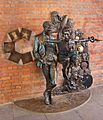David Bowie facts for kids
Quick facts for kids
David Bowie
|
|
|---|---|

Bowie in 2002
|
|
| Born |
David Robert Jones
8 January 1947 London, England
|
| Died | 10 January 2016 (aged 69) New York City, New York, US
|
| Occupation |
|
| Years active | 1962–2016 |
|
Works
|
|
| Spouse(s) |
|
| Children | 2, including Duncan Jones |
| Awards | Full list |
| Musical career | |
| Genres | |
| Instruments |
|
| Labels | |
David Robert Jones (born 8 January 1947 – died 10 January 2016), known as David Bowie, was an English singer, songwriter, and actor. He was a very important person in the music world. Many people think he was one of the most influential musicians of the 20th century. Bowie was praised by critics and other musicians, especially for his creative work in the 1970s. His career was known for constantly changing his style and how he looked. His music and stage shows had a big impact on popular music.
Bowie became interested in music when he was young. He studied art, music, and design before starting his music career in 1963. His song "Space Oddity", released in 1969, was his first big hit in the UK. After trying different things, he became famous in 1972 during the glam rock era. He created a flashy and unique character called Ziggy Stardust. This character became very popular with his hit song "Starman" and the album The Rise and Fall of Ziggy Stardust and the Spiders from Mars.
In 1975, Bowie changed his music style again to something he called "plastic soul". This new sound made some of his UK fans confused at first. But it helped him become very successful in the US. He had his first number-one hit there with "Fame" and the album Young Americans. In 1976, Bowie acted in the movie The Man Who Fell to Earth. He also released the album Station to Station. In 1977, he changed his style once more. He released the electronic album Low. This was the first of three albums he made with Brian Eno, known as the "Berlin Trilogy". The other two were "Heroes" (1977) and Lodger (1979). All these albums did well in the UK and were praised by critics.
After some ups and downs in the late 1970s, Bowie had three number-one hits. These were "Ashes to Ashes" (1980), the album Scary Monsters (and Super Creeps), and "Under Pressure" (1981), which he sang with Queen. His biggest success came in the 1980s with the album Let's Dance (1983). From 1988 to 1992, he was part of a hard rock band called Tin Machine. Then, he went back to his solo career in 1993.
Throughout the 1990s and 2000s, Bowie kept trying out new music styles. He also continued acting in movies. Some of his famous roles include Major Jack Celliers in Merry Christmas, Mr. Lawrence (1983), Jareth the Goblin King in Labyrinth (1986), and Nikola Tesla in The Prestige (2006). He stopped touring after 2004. His last live show was at a charity event in 2006. In 2013, Bowie released The Next Day, after not releasing new music for ten years. He continued making music until he died from liver cancer in New York City. He passed away two days after his 69th birthday and the release of his last album, Blackstar (2016).
During his life, David Bowie sold over 100 million records around the world. This makes him one of the best-selling musicians of all time. In the UK, he had 11 number-one albums. He was added to the Rock and Roll Hall of Fame in 1996. Rolling Stone magazine said he was one of the greatest artists in history. As of 2022, Bowie was the best-selling vinyl artist of the 21st century.
Contents
- Early Life and Musical Beginnings
- Music Career Highlights
- 1962–1967: Starting Out
- 1968–1971: Space Oddity to Hunky Dory
- 1972–1974: The Glam Rock Era
- 1974–1976: "Plastic Soul" and The Thin White Duke
- 1976–1979: The Berlin Era
- 1980–1988: Pop Star Era
- 1989–1991: Tin Machine and Solo Return
- 1992–1998: Electronic Music Period
- 1999–2012: Later Years and Break
- 2013–2016: Final Albums
- 2016–Present: Music After His Death
- Acting Career
- Other Creative Works
- Legacy and Influence
- Personal Life
- Death
- Awards and Achievements
- Discography
- Images for kids
- See also
Early Life and Musical Beginnings
David Bowie was born David Robert Jones on 8 January 1947 in Brixton, London. His mother, Margaret Mary "Peggy", worked as a waitress. His father, Haywood Stenton "John" Jones, worked for a children's charity. The family lived in south London. David went to Stockwell Infants School. He was known as a talented and determined child.
In 1953, Bowie's family moved to Sundridge Park. He attended Burnt Ash Junior School. His voice was okay for the school choir. He was good at playing the recorder. When he was nine, his dancing in music classes was very creative. Teachers called his moves "vividly artistic". His interest in music grew when his father brought home American records. These included songs by Elvis Presley and Little Richard. Bowie later said that listening to Little Richard's "Tutti Frutti" was like "hearing God".
Bowie was first impressed by Elvis Presley in 1956. He saw his cousin Kristina dance to "Hound Dog". By the end of the next year, Bowie learned the ukulele and tea-chest bass. He started playing piano and joined friends for skiffle music. He would perform songs by Presley and Chuck Berry for his local Cub Scout group. His father encouraged his dreams of being an entertainer. He even took David to meet famous performers like Alma Cogan and Tommy Steele. After primary school, Bowie went to Bromley Technical High School.
Bowie's older half-brother, Terry Burns, had a big influence on him. Terry introduced David to many things. These included modern jazz, Buddhism, Beat poetry, and the occult.
Bowie studied art, music, and design. After Terry introduced him to modern jazz, his mother gave him a Grafton saxophone in 1961. He soon took lessons from baritone saxophonist Ronnie Ross.
In 1962, Bowie got a serious eye injury at school. His friend George Underwood accidentally punched him during a fight over a girl. After many operations, doctors couldn't fully fix the damage. Bowie was left with poor depth perception. His left pupil stayed permanently wide open (called anisocoria). This made it look like his eyes were different colors. This eye became one of Bowie's most famous features. Despite the fight, Bowie and Underwood remained friends. Underwood later created artwork for Bowie's early albums.
Music Career Highlights
1962–1967: Starting Out
Bowie formed his first band, the Konrads, in 1962 when he was 15. They played rock and roll at local events. When Bowie left school, he told his parents he wanted to be a pop star. He left the Konrads and joined the King Bees. He tried to get famous businessman John Bloom to manage them. Bloom didn't respond, but he referred Bowie to Leslie Conn. Conn became Bowie's first manager.
Bowie's first single, "Liza Jane", was not a hit. He then joined the Manish Boys, a blues band. Their song "I Pity the Fool" also didn't do well. Bowie then joined the Lower Third, a blues trio. Their single "You've Got a Habit of Leaving" also failed. Bowie's contract with Conn ended. He then got a new manager, Ralph Horton. Horton helped him get a contract with Pye Records.
Bowie changed his stage name to David Bowie in 1966. He didn't want to be confused with Davy Jones of the Monkees. He chose the name after the 19th-century American pioneer James Bowie. His first song as David Bowie was "Can't Help Thinking About Me". It was not a success.
After leaving the Lower Third, Bowie released two more singles with a new band called the Buzz. Then he signed with Deram Records. His manager, Kenneth Pitt, helped him. In April 1967, his solo single, "The Laughing Gnome", did not make the charts. His first album, David Bowie, came out six weeks later. It mixed pop, psychedelia, and music hall. It also wasn't a hit. This was his last release for two years.
1968–1971: Space Oddity to Hunky Dory
Bowie studied acting and mime with Lindsay Kemp. He learned to create different characters for his performances. In 1969, he formed a group called Feathers with Hermione Farthingale and John Hutchinson. They played folk music, poetry, and mime.
On 11 July 1969, "Space Oddity" was released. It came out five days before the Apollo 11 moon landing. The song reached the top five in the UK. Bowie's second album, also called David Bowie, came out in November. It was later reissued as Space Oddity. The album had philosophical lyrics about peace and love. It was folk rock with some harder rock parts. It was not a big commercial success at first.
Bowie met Angela Barnett in April 1969. They got married within a year. She had a big impact on his career.
Bowie's third album, The Man Who Sold the World (1970), was different. It moved from acoustic folk-rock to a harder rock sound. To promote it, Bowie toured America in early 1971.
Hunky Dory (1971) showed a change towards art pop and melodic pop rock. It included songs like "Kooks", which he wrote for his son, Duncan Zowie Haywood Jones, born on 30 May. The album also explored more serious topics. It was released through RCA Records but didn't sell well because it wasn't promoted much.
1972–1974: The Glam Rock Era
Bowie launched his Ziggy Stardust stage show on 10 February 1972. He wore a striking costume and had reddish-brown hair. His band was called the Spiders from Mars. The show was very popular. It made him a huge star as he toured the UK. The Rise and Fall of Ziggy Stardust and the Spiders from Mars (1972) was released in June. It mixed hard rock with experimental pop. It is considered one of the most important glam rock albums.
"Starman", released in April before the album, helped Bowie break through in the UK. Both the song and album quickly became hits after his performance on Top of the Pops in July. The album stayed on the charts for two years. His older album Hunky Dory also became popular. At the same time, his non-album single "John, I'm Only Dancing" was a success. He also wrote and produced "All the Young Dudes" for Mott the Hoople, which was a hit. The Ziggy Stardust Tour then went to the United States.
After breaking up the Spiders from Mars, Bowie tried to move on from his Ziggy character. His older albums became very popular. The Man Who Sold the World and Space Oddity were re-released in 1972. "Life on Mars?", from Hunky Dory, was released in June 1973 and reached number three in the UK. In September, his 1967 song "The Laughing Gnome" reached number six. Pin Ups, an album of cover songs, came out in October. It had a UK number three hit with his version of "Sorrow". Pin Ups itself reached number one. This made David Bowie the best-selling artist of 1973 in the UK. He had six albums on the UK chart at the same time.
1974–1976: "Plastic Soul" and The Thin White Duke
Bowie moved to the US in 1974. He first stayed in New York City, then settled in Los Angeles. His album Diamond Dogs (1974) showed him moving towards soul and funk music. The album was about a wild future in a city after a disaster. It also had ideas from George Orwell's book 1984. The album reached number one in the UK and number five in the US. It had hit songs like "Rebel Rebel" and "Diamond Dogs". To promote the album, Bowie started the Diamond Dogs Tour in North America. After a break, the tour focused more on soul music.
The songs recorded in Philadelphia became the album Young Americans (1975). Bowie called the album's sound "plastic soul". This was a big change in style. It made some of his UK fans unhappy at first. But Young Americans gave Bowie his first US number-one hit, "Fame". He wrote this song with John Lennon, who also sang backing vocals. Bowie was one of the first white artists to appear on the US TV show Soul Train. He performed "Fame" and "Golden Years" on the show. Young Americans was a success in both the US and the UK. A re-release of his 1969 song "Space Oddity" became Bowie's first number-one hit in the UK.

Station to Station (1976) introduced a new Bowie character, "The Thin White Duke". This character looked like Thomas Jerome Newton, the alien Bowie played in the movie The Man Who Fell to Earth. The album continued the funk and soul sound of Young Americans. It also used a lot of synthesizers, which hinted at his next albums.
Station to Station was released in January 1976. A concert tour of Europe and North America followed in February. The Isolar – 1976 Tour featured songs from the album. The tour was very successful.
1976–1979: The Berlin Era
Before the end of 1976, Bowie became interested in the German music scene. He moved to West Berlin to try new things with his music. He often rode his bicycle between his apartment and Hansa Tonstudio, the recording studio he used. While working with Brian Eno and living with Iggy Pop, he started making minimalist, ambient music. These became the first of three albums, known as the Berlin Trilogy.
The album Low (1977) was influenced by German bands like Kraftwerk. It moved away from storytelling in Bowie's songs. The lyrics were less important. Low had the UK hit single "Sound and Vision". It reached number two in the UK charts.
The second album of the trilogy, "Heroes" (1977), also had a minimalist style. But it included more pop and rock. Bowie was joined by guitarist Robert Fripp. The album used different sounds, including synthesizers. It was another hit, reaching number three in the UK.
After finishing Low and "Heroes", Bowie spent much of 1978 on the Isolar II world tour. He performed songs from the first two Berlin Trilogy albums for almost a million people. Recordings from the tour were released as the live album Stage. Bowie also narrated a version of Sergei Prokofiev's classical piece Peter and the Wolf.
The last album in the "triptych" (a group of three works) was Lodger (1979). It was less minimalist than the others. It went back to the drum and guitar-based rock and pop of his earlier work. The album was a mix of new wave and world music. It was recorded in Switzerland. Lodger reached number four in the UK and number 20 in the US. It had UK hit singles "Boys Keep Swinging" and "DJ".
1980–1988: Pop Star Era
Scary Monsters (and Super Creeps) (1980) had the number-one hit "Ashes to Ashes." Critics thought Scary Monsters was more direct than the Berlin albums. It had strong guitar parts from Robert Fripp and Pete Townshend. As "Ashes to Ashes" hit number one in the UK, Bowie began a five-month run on Broadway. He starred as John Merrick in the play The Elephant Man.
Bowie teamed up with Queen in 1981 for the song "Under Pressure". This duet was a big hit. It became Bowie's third UK number-one single. In 1982, Bowie played the main role in a BBC TV show of Bertolt Brecht's play Baal. An EP of songs from the play was released. In March 1982, Bowie's song "Cat People (Putting Out Fire)" was released. It was the title song for the movie Cat People. It became a minor hit in the US and reached the UK Top 30.
Bowie became most popular in 1983 with Let's Dance. Chic's Nile Rodgers helped produce it. The album sold millions of copies in the UK and US. Its three singles became Top 20 hits in both countries. The title track reached number one. "Modern Love" and "China Girl" both reached number two in the UK. The album was followed by the Serious Moonlight Tour. This world tour lasted six months and was very popular. Bowie won two awards at the 1984 MTV Video Music Awards.
Tonight (1984) was another dance-oriented album. Bowie worked with Tina Turner and Iggy Pop on it. It included cover songs, like the 1966 Beach Boys hit "God Only Knows". The album had the hit song "Blue Jean". This song inspired a short film called Jazzin' for Blue Jean, which won Bowie a Grammy Award. Bowie performed at Wembley Stadium in 1985 for Live Aid. This was a concert to help people affected by famine in Ethiopia. During the event, a video for a fundraising song was shown. It was a duet between Bowie and Mick Jagger called "Dancing in the Street". It quickly became a number-one hit.
1989–1991: Tin Machine and Solo Return
Bowie stopped his solo career in 1989. He joined a band called Tin Machine. It was a hard-rocking group. The band's first album, Tin Machine (1989), was popular at first. It reached number three in the UK.
Tin Machine's first world tour was successful. However, fans and critics found it hard to see Bowie as just a band member. Tin Machine's singles didn't do well. Bowie became unhappy with being just one member of a band. He put Tin Machine on hold and returned to his solo work. He performed his early hits during the seven-month Sound+Vision Tour. He found success and praise again.
In October 1990, Bowie met Somali-born supermodel Iman. They married in 1992.
1992–1998: Electronic Music Period
On 20 April 1992, Bowie performed at The Freddie Mercury Tribute Concert. Four days later, Bowie and Iman got married in Switzerland. They decided to live in New York.
In 1993, Bowie released his first solo album since Tin Machine, Black Tie White Noise. It was influenced by soul, jazz, and hip-hop. The album used a lot of electronic instruments. It brought Bowie back to popularity, reaching number one in the UK. It had three Top 40 hits, including "Jump They Say".
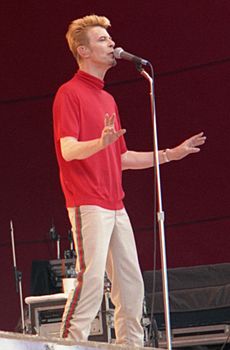
Bowie worked with Brian Eno again on Outside (1995). This album was successful in the UK and US. It had three Top 40 UK singles. On 7 January 1997, Bowie celebrated his 50th birthday with a concert at Madison Square Garden in New York. Many famous musicians joined him on stage.
Earthling (1997) included sounds from British jungle and drum 'n' bass. It was a success in the UK and US. Two singles from the album, "Little Wonder" and "Dead Man Walking", became UK Top 40 hits. Bowie received a star on the Hollywood Walk of Fame on 12 February 1997. The Earthling Tour took place in Europe and North America in 1997.
1999–2012: Later Years and Break

In October 2001, Bowie opened the Concert for New York City. This was a charity event to help victims of the September 11 attacks. He performed "America" and "'Heroes'". In 2002, he released Heathen. He then went on the Heathen Tour in Europe and North America. The tour started at London's Meltdown festival, where Bowie was the artistic director that year.
Reality (2003) followed. Its world tour, the A Reality Tour, had about 722,000 attendees. It made more money than any other tour in 2004. On 13 June, Bowie performed at the Isle of Wight Festival 2004. This was his last live show in the UK. On 25 June, he felt chest pain while performing in Germany. It was later found to be a blocked coronary artery. He needed emergency surgery. The remaining 14 dates of the tour were cancelled.
After recovering from his heart attack, Bowie performed less often. He made only a few appearances on stage and in the studio.
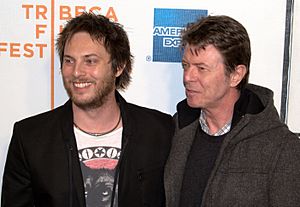
Bowie received the Grammy Lifetime Achievement Award on 8 February 2006. In April, he announced he was taking a year off from touring and making albums.
In March 2011, Toy, an unreleased album from 2001, was leaked online. It had songs used for Heathen and new versions of his early songs.
2013–2016: Final Albums
On 8 January 2013, his 66th birthday, Bowie announced a new album called The Next Day. It was set to be released in March. A single, "Where Are We Now?", was released immediately. It quickly topped the UK iTunes Chart. It debuted at number six in the UK Singles Chart. This was his first Top 10 single in two decades.
In mid-2014, Bowie was diagnosed with liver cancer. He kept this private. In September 2014, new information came out about his next album, Nothing Has Changed. It was released in November. The album included rare tracks and old songs, plus a new song called "Sue (Or in a Season of Crime)". On 7 December 2015, Bowie's musical Lazarus opened in New York. His last public appearance was at the opening night of this show.
Blackstar was released on 8 January 2016, Bowie's 69th birthday. It received great reviews. After his death on 10 January, his producer Tony Visconti said Bowie had planned the album as his "swan song" and a "parting gift" for his fans. Many people noticed that the lyrics on the album seemed to be about his upcoming death. On 15 January, Blackstar debuted at number one on the UK Albums Chart. Nineteen of his albums were in the UK Top 100 Albums Chart. Blackstar also reached number one in other countries, including the US.
2016–Present: Music After His Death
In September 2016, a box set called Who Can I Be Now? (1974–1976) was released. It covered Bowie's mid-1970s soul period. It included The Gouster, an album from 1974 that had not been released before. An EP (Extended Play) called No Plan was released on 8 January 2017. This would have been Bowie's 70th birthday. It included three songs Bowie recorded during the Blackstar sessions. A music video for the title track was also released. In 2017 and 2018, several live albums were released. These included recordings from his tours in 1974, 1976, and 1978. In the two years after his death, Bowie sold 5 million records in the UK alone. In 2016, the International Federation of the Phonographic Industry named Bowie the second-best-selling artist worldwide.
At the 59th Annual Grammy Awards in 2017, Bowie won all five awards he was nominated for. These included Best Rock Performance and Best Alternative Music Album. These were Bowie's first Grammy wins for his music. On 8 January 2020, a previously unreleased version of "The Man Who Sold the World" was released. Two other releases were announced: an EP, Is It Any Wonder?, and an album, ChangesNowBowie. In August 2020, more live shows were released. These were part of a series of live concerts from his tours between 1995 and 1999. They were released in late 2020 and early 2021 as part of the box set Brilliant Live Adventures. In September 2021, Bowie's estate signed a deal with Warner Music Group. This deal covers Bowie's recordings from 2000 to 2016. Bowie's album Toy, recorded in 2001, was released on what would have been his 75th birthday. In January 2022, Variety reported that Bowie's estate sold his publishing catalogue to Warner Chappell Music for over $250 million.
Acting Career
Even though he was mainly a musician, Bowie also acted throughout his career. He appeared in over 30 films, TV shows, and plays. Many critics have said that if Bowie hadn't chosen music, he could have been a very successful actor. Others have noted that his best contributions to film were when his songs were used in movies.
Bowie's acting career started before he became famous as a musician. He studied avant-garde theatre and mime. In 1967, he played Cloud in a play called Pierrot in Turquoise. He also had a small role in a BBC drama in 1968. In the short film The Image (1969), he played a ghostly boy. He also had a brief appearance as an extra in the film The Virgin Soldiers that same year.
In 1976, Bowie received praise for his first major film role. He played Thomas Jerome Newton, an alien, in The Man Who Fell to Earth.
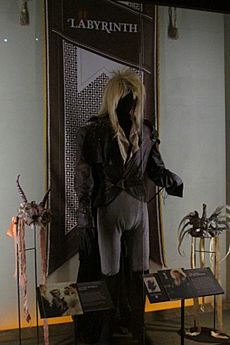
Bowie played Joseph Merrick in the Broadway play The Elephant Man. He wore no stage make-up and was highly praised for his performance. He played the role 157 times between 1980 and 1981. The movie Christiane F. – We Children from Bahnhof Zoo featured Bowie in a cameo appearance as himself. Its soundtrack album, Christiane F. (1981), had many songs from his Berlin Trilogy albums. In 1982, he starred in a BBC TV version of the play Baal. In Nagisa Oshima's film, Merry Christmas, Mr. Lawrence, Bowie played Major Jack Celliers, a prisoner of war. Bowie also had a small role in the 1983 comedy Yellowbeard.
To promote the single "Blue Jean", Bowie filmed a 21-minute short film called Jazzin' for Blue Jean (1984). He played two roles in it: romantic hero Vic and arrogant rock star Screaming Lord Byron. This short film won Bowie his only Grammy award during his lifetime. Bowie had a supporting role as hitman Colin in the 1985 film Into the Night. He turned down the role of villain Max Zorin in the James Bond film A View to a Kill (1985).
Bowie worked with director Julien Temple again for Absolute Beginners (1986). This was a rock musical film about life in London in the late 1950s. Bowie played an ad man named Vendice Partners. In the same year, Jim Henson's fantasy film Labyrinth cast him as Jareth, the evil Goblin King. The film became a cult film. Two years later, he played Pontius Pilate in Martin Scorsese's movie The Last Temptation of Christ (1988).
In 1991, Bowie played a disgruntled restaurant employee in the film The Linguini Incident. Bowie also played the mysterious FBI agent Phillip Jeffries in David Lynch's Twin Peaks: Fire Walk with Me (1992). He had a small but important role as his friend Andy Warhol in Basquiat (1996). Bowie co-starred in the Western film Il Mio West (1998). He played the aging gangster Bernie in Everybody Loves Sunshine (1999). He also appeared as the host in the second season of the TV horror series The Hunger. In 1999, Bowie voiced two characters in the video game Omikron: The Nomad Soul. This was his only appearance in a video game.
Other Creative Works
Painter and Art Collector
Bowie was also a painter and artist. In 1976, he moved to Switzerland. He bought a house in the hills near Lake Geneva. In this new place, he had more time for painting. He created many post-modern art pieces. When he was on tour, he would sketch in a notebook and take photos for later use. Bowie visited art galleries in Geneva and Berlin. He became a "prolific producer and collector of contemporary art." He also became a well-known supporter of expressionist art. He started studying classical music and literature.
One of Bowie's paintings sold at auction in 1990 for $500. The cover for his 1995 album Outside is a close-up of a self-portrait he painted that year. His first solo art show was in 1995 in London. In 1997, he started a publishing company called 21 Publishing. A year later, Bowie was invited to join the editorial board of Modern Painters journal. He also took part in the Nat Tate art hoax that year. In an interview with The New York Times, he said, "Art was, seriously, the only thing I'd ever wanted to own." His art collection included works by famous artists like Damien Hirst and Jean-Michel Basquiat. It was valued at over £10 million in 2016.
After his death, his family decided to sell most of the collection. They said they "didn't have the space" to store it. In November, three auctions were held at Sotheby's in London. The exhibitions attracted over 51,000 visitors. The auctions made a total of £32.9 million (about $41.5 million). The highest-selling item was Basquiat's painting Air Power, which sold for £7.09 million.
Writings
Besides music, Bowie also wrote in different ways. In the late 1990s, he wrote essays and forewords for books. These included an essay on Jean-Michel Basquiat for a book called Writers on Artists. He also wrote forewords for photography books and his wife Iman's book I Am Iman. He contributed a lot to the 2002 book Moonage Daydream, which was about his Ziggy Stardust years.
Bowie also wrote notes for several albums. These included albums by Robin Clark, Stevie Ray Vaughan, and the Spinners. He also wrote an appreciation piece for Nine Inch Nails in Rolling Stone magazine in 2005. He wrote an essay for Iggy Pop's album A Million in Prizes: The Anthology.
Legacy and Influence
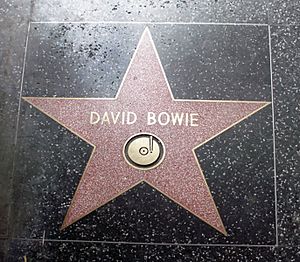
Bowie's songs and stage performances brought something new to popular music in the early 1970s. He greatly influenced music then and in the future. Music historians say Bowie was a pioneer of glam rock. He also inspired the punk rock movement. Bowie's record company promoted his unique status with the slogan, "There's old wave, there's new wave, and there's David Bowie."
Bowie's influence grew because he kept reinventing himself. Biographer Thomas Forget said, "Because he has succeeded in so many different styles of music, it is almost impossible to find a popular artist today that has not been influenced by David Bowie." In 2000, other music stars voted Bowie the "most influential artist of all time" in a poll by NME. Alexis Petridis of The Guardian wrote that by 1980, Bowie was "the most important and influential artist since the Beatles." Neil McCormick of The Daily Telegraph said Bowie had "one of the supreme careers in popular music, art and culture of the 20th century." He added that Bowie was "too inventive, too strange for all but his most devoted fans to keep up with."
The BBC's Mark Easton said Bowie helped make Britain a "creative powerhouse." He challenged future generations "to aim high, to be ambitious and provocative, to take risks." Easton concluded that Bowie "changed the way the world sees Britain. And the way Britain sees itself." In 2006, Bowie was voted the fourth greatest living British icon in a BBC poll. Annie Zaleski of Alternative Press wrote, "Every band or solo artist who's decided to rip up their playbook and start again owes a debt to Bowie."
Many people in the music industry paid tribute to Bowie after he died. Tributes also came from outside entertainment, like from the Vatican and the German Federal Foreign Office. The German office thanked Bowie for his part in the fall of the Berlin Wall and mentioned his song "Heroes".
In January 2016, amateur astronomers in Belgium created a "Bowie asterism" (a group of stars that form a pattern). It shows the lightning bolt from his Aladdin Sane album cover. The stars were near Mars when Bowie died.
On 7 January 2017, the BBC broadcast a documentary called David Bowie: The Last Five Years. On 8 January 2017, what would have been Bowie's 70th birthday, a charity concert was held in his birthplace of Brixton. Actor Gary Oldman, a close friend, hosted it. A David Bowie walking tour through Brixton was also launched. Other events marking his birthday weekend included concerts in New York, Los Angeles, Sydney, and Tokyo.
On 6 February 2018, the first flight of the SpaceX Falcon Heavy rocket carried Elon Musk's personal Tesla Roadster and a mannequin named Starman into space. "Space Oddity" and "Life on Mars?" were playing on the car's sound system during the launch.
Personal Life
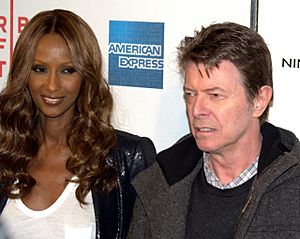
Bowie married his first wife, Mary Angela Barnett, on 19 March 1970 in London. Their son Duncan, born on 30 May 1971, was first known as Zowie. Bowie and Angela divorced on 8 February 1980. Bowie received custody of their son.
On 24 April 1992, Bowie married Somali-American model Iman in a private ceremony. The wedding was later made official on 6 June in Florence. Their marriage influenced Bowie's 1993 album Black Tie White Noise. They had one daughter, Alexandria "Lexi" Zahra Jones, born in August 2000. The couple lived mainly in New York City and London.
Philanthropy
Bowie was involved in charity work. He supported HIV/AIDS research in Africa. He also helped with other projects for disadvantaged children and developing nations. He worked to end poverty and hunger, promote human rights, and provide education and health care to children affected by war. Part of the money from the TV showing of Bowie's 50th birthday party in 1997 was given to the Save the Children charity.
Death
On 10 January 2016, Bowie died from liver cancer in his New York City apartment. He had been diagnosed 18 months earlier but had kept his condition private. The Belgian theatre director Ivo van Hove, who worked with Bowie on his musical Lazarus, said Bowie kept working during his illness.
After Bowie's death, fans gathered at special memorials in the streets. At the mural of Bowie in his birthplace of Brixton, south London, fans laid flowers and sang his songs. Other memorial sites were in Berlin, Los Angeles, and outside his apartment in New York. After the news of his death, sales of his albums and singles greatly increased. Bowie had said he did not want a funeral. According to his death certificate, he was cremated in New Jersey on 12 January. As he wished in his will, his ashes were scattered in a Buddhist ceremony in Bali, Indonesia.
Awards and Achievements
Bowie's 1969 hit song "Space Oddity" won him an Ivor Novello Special Award. For his acting in the 1976 film The Man Who Fell to Earth, he won the Saturn Award for Best Actor. Over the years, he received many awards for his music and music videos. These included six Grammy Awards and four Brit Awards. He won Best British Male Artist twice. He also received the Outstanding Contribution to Music award in 1996. The Brits Icon award was given to him after his death in 2016 for his "lasting impact on British culture."
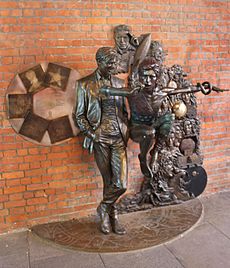
In 1999, the French government made Bowie a Commander of the Ordre des Arts et des Lettres. He also received an honorary doctorate from Berklee College of Music that year. He turned down the royal honour of Commander of the Order of the British Empire (CBE) in 2000. He also declined a knighthood in 2003. Bowie said he would "never have any intention of accepting anything like that."
During his lifetime, Bowie sold over 100 million records worldwide. This makes him one of the best-selling music artists. In the United Kingdom, he had 9 platinum, 11 gold, and 8 silver albums. In the United States, he had 5 platinum and 9 gold albums. Since 2015, Parlophone has re-released Bowie's older music in box sets. Bowie was named the best-selling vinyl artist of the 21st century in 2022.
Rolling Stone magazine's 500 Greatest Albums of All Time list includes several of Bowie's albums. These include The Rise and Fall of Ziggy Stardust and the Spiders from Mars (number 40) and Station to Station (number 52). On their 500 Greatest Songs of All Time list, Rolling Stone includes "'Heroes'" (number 23) and "Life on Mars?" (number 105). Four of his songs are in The Rock and Roll Hall of Fame's 500 Songs that Shaped Rock and Roll.
In a 2002 BBC poll of the 100 Greatest Britons, Bowie was ranked 29th. In 2004, Rolling Stone magazine ranked him 39th on their list of the 100 Greatest Artists of All Time. Bowie was inducted into the Rock and Roll Hall of Fame in 1996. He was also inducted into the Songwriters Hall of Fame in 2005. In 2013, he was inducted into the Science Fiction and Fantasy Hall of Fame. Days after Bowie's death, Rolling Stone writer Rob Sheffield called him "the greatest rock star ever." The magazine also listed him as the 39th greatest songwriter of all time. In 2022, Sky Arts ranked him the most influential artist in Britain of the last 50 years. He ranked 32nd on the 2023 Rolling Stone list of the 200 Greatest Singers of All Time.
In 2008, a spider species, Heteropoda davidbowie, was named in Bowie's honor. In 2011, his image was chosen for the B£10m note of the local currency in his birthplace, the Brixton Pound. On 5 January 2015, a main-belt asteroid was named 342843 Davidbowie. In March 2017, Bowie was featured on a series of UK postage stamps issued by the Royal Mail. On 25 March 2018, a statue of Bowie was unveiled in Aylesbury, Buckinghamshire. This town was where he first performed as Ziggy Stardust. The statue shows Bowie from 2002, with various characters and looks from his career.
Discography
- David Bowie (1967)
- David Bowie (1969)
- The Man Who Sold the World (1970)
- Hunky Dory (1971)
- The Rise and Fall of Ziggy Stardust and the Spiders from Mars (1972)
- Aladdin Sane (1973)
- Pin Ups (1973)
- Diamond Dogs (1974)
- Young Americans (1975)
- Station to Station (1976)
- Low (1977)
- "Heroes" (1977)
- Lodger (1979)
- Scary Monsters (and Super Creeps) (1980)
- Let's Dance (1983)
- Tonight (1984)
- Never Let Me Down (1987)
- Black Tie White Noise (1993)
- The Buddha of Suburbia (1993)
- Outside (1995)
- Earthling (1997)
- Hours (1999)
- Heathen (2002)
- Reality (2003)
- The Next Day (2013)
- Blackstar (2016)
Images for kids
-
Bowie performs with Cher on her TV show in 1975
-
Bowie performing in Turku, Finland, 1997
-
Bowie on stage with Sterling Campbell during the Heathen Tour, 2002
-
Bowie with his son Duncan Jones at the premiere of Jones's directorial debut Moon, 2009
-
Bowie's costume from Labyrinth at the Museum of Pop Culture, Seattle
-
Bowie's star on the Hollywood Walk of Fame
-
Bowie and wife Iman, 2009
-
Statue of Bowie in different guises in Aylesbury, Buckinghamshire, where he debuted Ziggy Stardust in 1972
See also
 In Spanish: David Bowie para niños
In Spanish: David Bowie para niños
- List of ambient music artists
- List of artists who reached number one in the United States
- List of artists who reached number one on the US Dance Club Songs chart
- List of Billboard number-one Dance Club songs
- List of Billboard number-one singles


